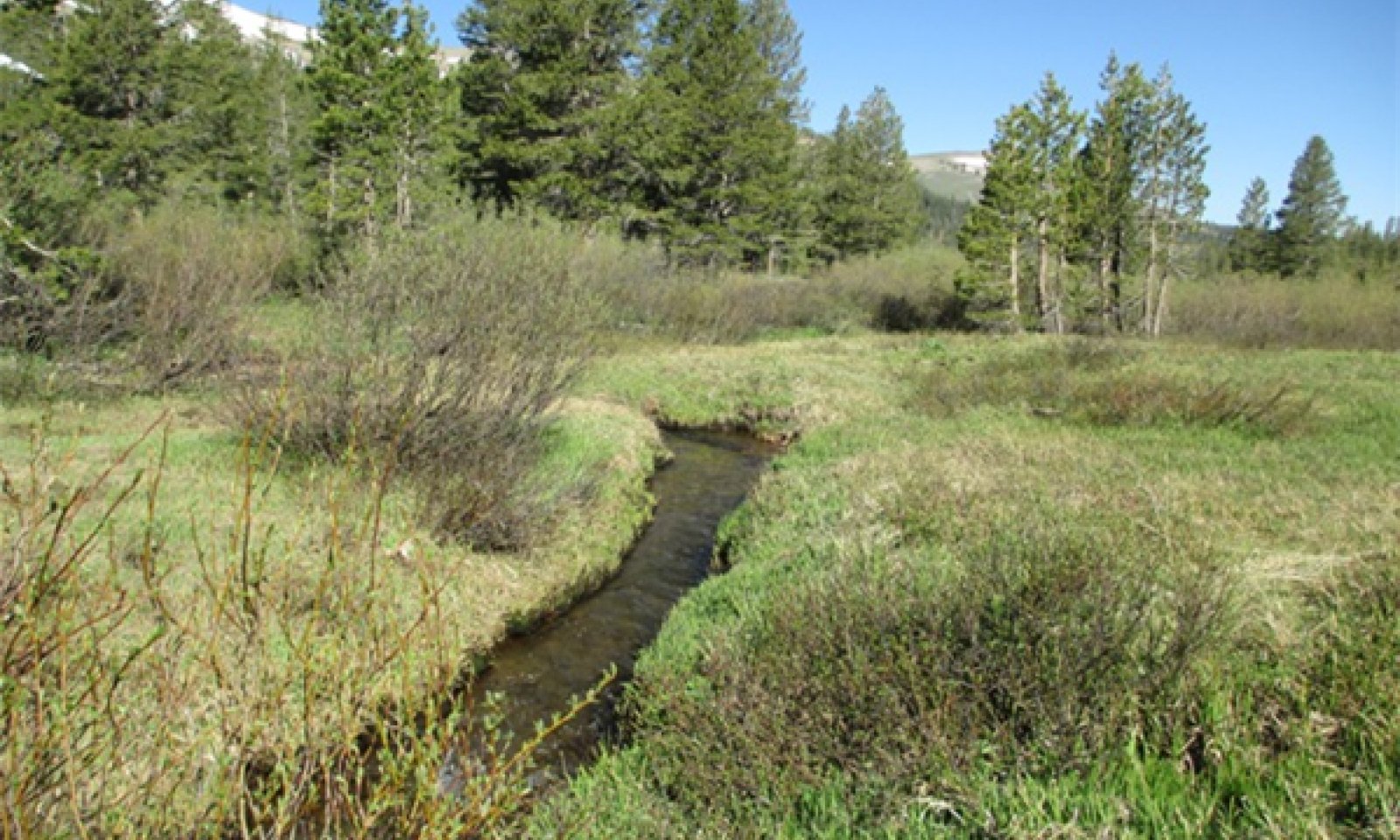

Natural Resources
Conservation Service
Ecological site R022AX103CA
Cryic E Meadow System
Accessed: 01/02/2025
General information
Provisional. A provisional ecological site description has undergone quality control and quality assurance review. It contains a working state and transition model and enough information to identify the ecological site.
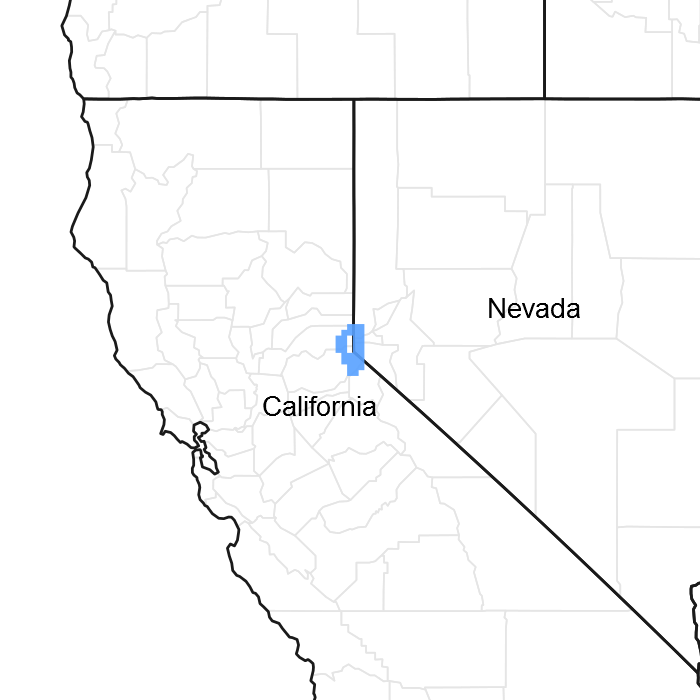
Figure 1. Mapped extent
Areas shown in blue indicate the maximum mapped extent of this ecological site. Other ecological sites likely occur within the highlighted areas. It is also possible for this ecological site to occur outside of highlighted areas if detailed soil survey has not been completed or recently updated.
MLRA notes
Major Land Resource Area (MLRA): 022A–Sierra Nevada and Tehachapi Mountains
Major Land Resource Area 22A, Sierra Nevada Mountains, is located predominantly in California and a small section of western Nevada. The area lies completely within the Sierra Nevada Section of the Cascade-Sierra Mountains Province. The Sierra Nevada range has a gentle western slope, and a very abrupt eastern slope. The Sierra Nevada consists of hilly to steep mountains and occasional flatter mountain valleys. Elevation ranges between 1,500 and 9,000 ft throughout most of the range, but peaks often exceed 12,000 ft. The highest point in the continental US occurs in this MLRA (Mount Whitney, 14,494 ft). Most of the Sierra Nevada is dominated by granitic rock of the Mesozoic age, known as the Sierra Nevada Batholith. The northern half is flanked on the west by a metamorphic belt, which consists of highly metamorphosed sedimentary and volcanic rocks. Additionally, glacial activity of the Pleistocene has played a major role in shaping Sierra Nevada features, including cirques, arêtes, and glacial deposits and moraines. Average annual precipitation ranges from 20 to 80 inches in most of the area, with increases along elevational and south-north gradients. Soil temperature regime ranges from mesic, frigid, and cryic. Due to the extreme elevational range found within this MLRA, Land Resource Units (LRUs) were designated to group the MLRA into similar land units.
LRU “X” represents ecological sites driven by abiotic features that override the typical soils or climatic features that drive most of the other LRU zones. In the Sierra Nevada these sites are typically driven by water features associated with lotic or lentic riparian systems. Other features maybe shallow bedrock, or unique chemical development which affects the growth of typical vegetation.
Ecological site concept
This riparian complex is associated with alluvial valley types (VIII) at elevations typically between 7,500 and 8,800 feet, with a reference E channel type (Rosgen 1996). The dominant soils are cryic, with deep rich A horizons. Histic soils are limited to the wettest areas along the streams, or associated with adjacent discharge slopes. These are typically first or second order streams associated with small alpine meadows. Dominant species are mountain willow (Salix eastwoodiae), Sierra willow (Salix orestera), mountain sedge (Carex scopulorum), and tufted hairgrass (Deschampsia cespitosa).
Associated sites
| F022AX101CA |
Moist Colluvial Headwater System This ecological site occurs on lacustrine fringe, or lake deltas with a Da type channel. |
|---|---|
| R022AX102CA |
Frigid E-C Meadow System This ecological site occurs at lower elevations, with a frigid temperature regime, and typically larger stream systems. It has an E-C type reference channel. |
| R022AX104CA |
Sphagnum Fen This ecological site occurs in depressional basins associated with sphagnum fens. Stream channels typically do not develop in the reference state. |
Similar sites
| R022AX007CA |
Subalpine, low to mid gradient E-channel riverine This ecological site has an E type reference channel, and occurs at higher elevations than this site. It occurs in the southern sierras, and may extend above treeline. |
|---|---|
| R022AX102CA |
Frigid E-C Meadow System This ecological site has similar stream succession dynamics, but different plant communities, due to the lower elevation of this site. |
Table 1. Dominant plant species
| Tree |
Not specified |
|---|---|
| Shrub |
(1) Salix eastwoodiae |
| Herbaceous |
(1) Carex scopulorum |
Physiographic features
This ecological site is found on flood plain or fens in higher elevation mountain valleys. Elevations may range from 6,990 feet and 9,300 feet, but are typically between 7,500 and 8,800 feet. Slopes range from 0 to 2 percent. It is found on all aspects.
Table 2. Representative physiographic features
| Landforms |
(1)
Flood plain
(2) Fen |
|---|---|
| Flooding duration | Very long (more than 30 days) |
| Flooding frequency | None to frequent |
| Ponding duration | Brief (2 to 7 days) to very long (more than 30 days) |
| Ponding frequency | None to frequent |
| Elevation | 2,131 – 2,835 m |
| Slope | 0 – 2% |
| Ponding depth | 0 – 25 cm |
| Water table depth | 0 – 51 cm |
| Aspect | Aspect is not a significant factor |
Climatic features
The average annual precipitation is 33 to 65 inches, mostly in the form of snow in the winter months from November through April. The average annual air temperature is 37 to 41 degrees Fahrenheit, and the frost-free (>32F) season is 20 to 60 days. The freeze-free (>28F) season is 30 to 90 days.
The monthly data below is from the Echo Summit climate station listed below. This station is the closest to this ecological site in elevation and distance. However, this climate station is on a hillslope, and this ecological site is associated with meadows and valley floors where temperatures tend to be cooler. The monthly precipitation data below represent the average total monthly precipitation.
Table 3. Representative climatic features
| Frost-free period (average) | 40 days |
|---|---|
| Freeze-free period (average) | 60 days |
| Precipitation total (average) | 1,219 mm |
Figure 2. Monthly average minimum and maximum temperature
Figure 3. Annual precipitation pattern
Figure 4. Annual average temperature pattern
Influencing water features
This site is a low gradient riparian system, associated with E type channels.
Soil features
The Bidart, Bidart wet phase, and Hellhole soils are associated with this ecological site. These soils are associated with different fluvial surfaces, and vary in wetness and organic matter accumulation. These soils are all very deep, and formed in alluvium from mixed parent material or deep mossy organic matter. These soils are very poorly drained with moderate to rapid (Hellhole) permeability. The soil moisture regime is aquic and the soil temperature regime is cryic or frigid (Hellhole). Surface and subsurface rock fragments are typically absent.
Soils by fluvial surface:
Discharge slopes and depressional basins:
The Hellhole soil occurs in areas with permanent high water tables, which allows deep organic soils to develop from moss fibers. The hellhole soils are Euic, frigid Typic Sphagnofibrists. They are rarely flooded for brief durations, but are frequently ponded (saturated) for long durations. Available water capacity is 21.7 to 25.6 inches in the upper 40 inches of soil (ESIS does not allow AWC greater than 15.99 to be entered). CC1 and CC2 are associated with this component.
Floodplain, Frequently Flooded:
The Bidart, wet phase occurs on the active floodplains. The Bidart soils have a mucky silt loam surface texture, with silt loam, extremely gravelly coarse sand, fine sandy loam, and sandy loam subsurface textures. These soils exhibit episodic depositional layers. Mottling from water saturation is evident at 3 inches, with gleyed conditions starting at 17 inches. The Bidart soils are coarse-loamy, mixed, superactive, acid Fluvaquentic Cryaquepts. The Bidart wet phase is frequently flooded and ponded for long durations. CC3 is associated with this component.
Floodplains, Occasionally Flooded
The Bidart silt loam component has the same features as describe for the Bidart wet phase, but it is occasionally flooded and ponded, due to its higher topographic position on the floodplain. CC4 is associated with this component.
This ecological site occurs in following mapunits and components in the Lake Tahoe Basin:
Mapunit;Mapunit name;Component;Phase;Percent
7021;Hellhole peat, 0 to 2 percent slopes;Bidart;wet;10
7071;Watah peat, 0 to 2 percent slopes;Bidart;wet;2
9001;Bidart complex, 0 to 2 percent slopes;Bidart;wet;30
9001;Bidart complex, 0 to 2 percent slopes;Bidart;mucky silt loam;50
9001;Bidart complex, 0 to 2 percent slopes;Hellhole;;2
Table 4. Representative soil features
| Parent material |
(1)
Alluvium
–
granite
(2) Mossy organic material – volcanic breccia |
|---|---|
| Surface texture |
(1) Mucky silt loam |
| Family particle size |
(1) Loamy |
| Drainage class | Poorly drained |
| Permeability class | Moderate to rapid |
| Soil depth | 152 cm |
| Surface fragment cover <=3" | 0% |
| Surface fragment cover >3" | 0% |
| Available water capacity (0-101.6cm) |
13.97 – 40.61 cm |
| Soil reaction (1:1 water) (0-101.6cm) |
4.5 – 6 |
| Subsurface fragment volume <=3" (Depth not specified) |
0% |
| Subsurface fragment volume >3" (Depth not specified) |
0% |
Ecological dynamics
Abiotic Features:
This riparian complex is associated with alluvial valley types (VIII), with a reference E channel type (Rosgen 1996). The dominant soils are cryic, with deep rich A horizons. Histic soils are limited to the wettest areas along the streams, or associated with adjacent discharge slopes. These are typically first or second order streams associated with small alpine meadows. Dominant species are mountain willow (Salix eastwoodiae), Sierra willow (Salix orestera), mountain sedge (Carex scopulorum), and tufted hairgrass (Deschampsia cespitosa).
Hydrologic factors:
These small, low gradient streams meander through alpine meadows with narrow and deep E type channels. E type channels typically have thick mats of sedge roots which stabilize channel banks and help maintain a low channel width-to-depth ratio and high stream sinuosity. These small channels frequently flood onto the floodplain leaving fine deposits on the surface. The floodplains have a shallow water table that supports rhizomatous sedges and many obligate wetland species.
E type channels are often considered stable systems, but they respond quickly to disturbances, which may cause channel incision or bank erosion. This can shift an E type channel towards a G type channel. E type channels can become unstable due to disturbances that impact the stream bank vegetation, change the flow regime, or alter the channel morphology. Overgrazing and excessive trampling by livestock can reduce streambank stability by reducing vegetative cover or physically trampling the banks. Continued disturbance can cause the stream to erode and incise deeper into the alluvial sediments, containing high flows within the channel, and reducing or eliminating overbank flows onto the floodplain. The incision and stream confinement creates a deep, narrow, eroded G type channel. Overtime, the G type channel is widened by bank erosion, and a wide, entrenched F type channel develops. These channels (“G” and “F”) generally lose wetland obligate species because the water table is lower and flow is disconnected from the floodplain. Floodplains associated with G and F type channels become dominated by upland grass, shrub and/or forest plant communities. The banks are often bare due to active erosion. As the F channel obtains sufficient width, erosive scour is reduced, and vegetation can establish on the banks and along the greenline. Channel meander and point bar development occurs in the entrenched channel, allowing a new entrenched C type channel to develop. The entrenched C channel supports wetland plant communities but it is confined to the lower floodplain by the incised banks. The abandoned floodplain remains with a lower water table and supports a greater proportion of upland plants. E channels may develop within the floodplain of the C channel, as sedges continue to capture fine sediments and stabilize banks.
Disturbance Factors:
These upper elevation meadows are generally less disturbed than the lower elevation meadows around Lake Tahoe. The main disturbance in higher elevation meadows is from historic grazing. Grazing has altered the composition and cover of the native vegetation, and caused changes in channel morphology in some areas. More remote meadows are less impacted.
During the mid-1800’s approximately 80 percent of the forests in Tahoe were clear-cut during the Comstock era (Elliott-Fisk et al. 1996). Tree removal increased erosion on adjacent mountain slopes and increased sediment supply to these river systems. Removal of trees would also have reduced water loss to evapotranspiration and increased water flow into the streams. The side effects of the logging era on the stream morphology are unknown, but likely increased sediment supply and stream volume in these systems. Davis (, 1996) report increased erosion between 1850 and 1900 based on analysis of cores from Lake Tahoe. The erosion was attributed to logging, grazing and road development during this period. During the same period, there was an increase in the algae Pediastrum, and an increase in sedge (Carex spp.) pollen, possibly due to increased nutrient loading into the lake and tributaries.
The meadows in the Lake Tahoe Basin were grazed in the past by cattle and sheep. Over 13 dairy farms were active in the basin, and most meadows were fenced for cattle grazing. Sheep roamed the mountains, and denuded much of the forbs and grasses (Elliott-Fisk et al. 1996). Cattle concentrate in riparian habitats because of access to water and forage, shade and gentle landscapes (Kie and Boroski 1996). Cattle may have affected the present composition of vegetation by selectively grazing species such as grasses, and trampling susceptible species. Grazing can affect channel morphology by removing bank stabilizing vegetation such as willows, and by trampling stream banks when accessing the stream.
Beavers were once thought to be non-native to the Sierra Nevada, but carbon dating of old beaver dams has shown that beavers were in the Sierra Nevada since AD 580 (James and Lanman 2012, Landman et al. 2012). Beaver trapping and extirpation efforts eliminated beavers from the higher Sierra Nevada by mid-1800s. Beavers were reintroduced into the Lake Tahoe Basin from 1939 to 1949 (Beier and Barrett 1987) after 100 years or more of absence. Nine beavers were introduced from the Snake River in Idaho to the Truckee River. Since then populations have expanded to many watersheds around Lake Tahoe. In 1987 there were 0.72 colonies (3.5 beavers) per km of stream along the Truckee River (Beier and Barrett 1987).
Beavers develop dams to create deeper water for mobility, safety, and den building (Beier and Barrett 1987). Dam building raises the water table above the dam, causing pond development and flooding across the floodplain. Below the beaver dam, or after dams are removed, the channel may become unstable and scour or widen depending upon the site. The historic impact of beaver on this site is unknown, but they likely influenced the development of these streams and meadows.
Ecological sites associated with lotic stream systems are developed using channel evolution models. Stream systems are dynamic and continually evolve to reach a stable equilibrium. Streams develop identifiable stages of development based on channel morphology (Rosgen 1997). These stages are identified using a state and transition model based on stream evolution models.
The reference state is typically the pre-settlement, most successionally advanced and hydrologically stable community phase (numbered 1.1), and the community phases that result from natural and human disturbances. Community phase 1.1 is deemed the phase representative of the most successionally advanced pre-European plant/animal community including beaver activity and hydrologic conditions that influence its composition and production. Because this phase is partly determined from reconstruction and/or historic literature, some speculation is necessarily involved in describing it.
All tabular data listed for a specific community component within this ecological site description represent a summary of one or more field data collection plots taken in modal communities within the community component. Although such data are valuable in understanding the community component (kinds and amounts of ground and surface materials, canopy characteristics, community phase overstory and understory species, production and composition, and growth), they do not represent the absolute range of characteristics or an exhaustive listing of all species that may occur in that phase over the geographic range of the ecological site.
State and transition model
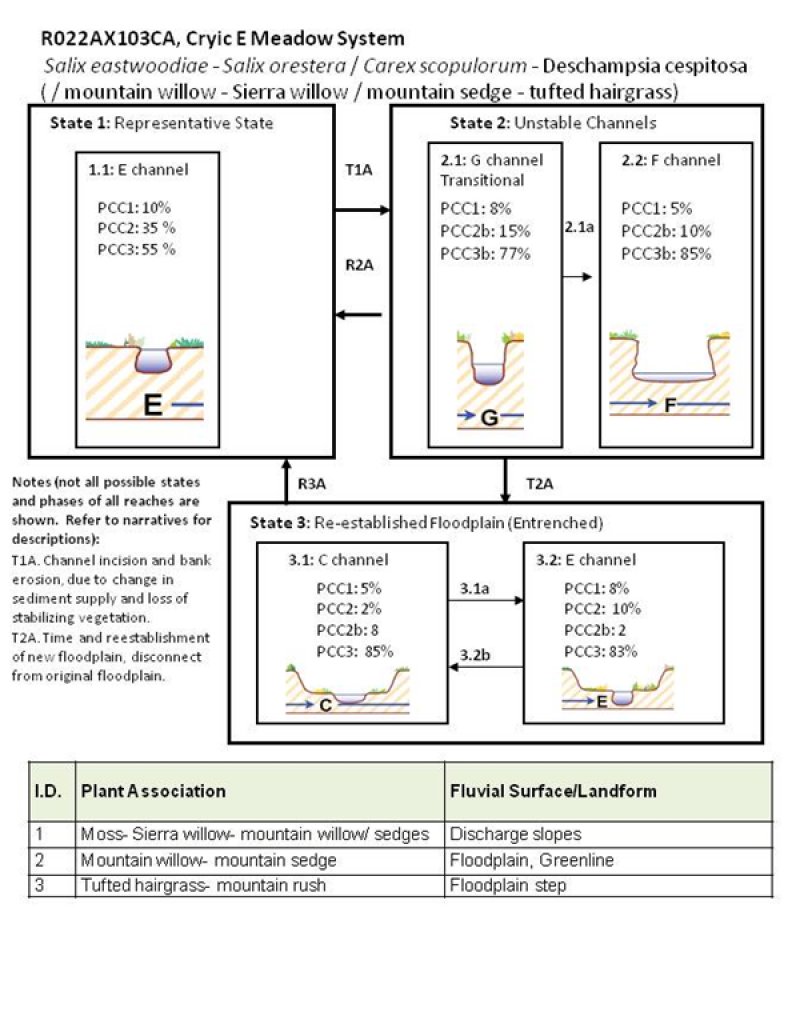
Figure 5. R022AX103CA STM
More interactive model formats are also available.
View Interactive Models
More interactive model formats are also available.
View Interactive Models
Click on state and transition labels to scroll to the respective text
State 1 submodel, plant communities
State 2 submodel, plant communities
State 3 submodel, plant communities
State 1
Reference State
This state is the reference state for this ecological site. It is defined by an E type Rosgen channel.
Community 1.1
E Channel

Figure 6. E channel
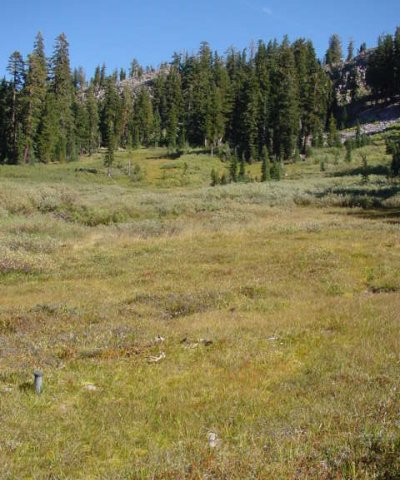
Figure 7. CT1 Discharge Slope
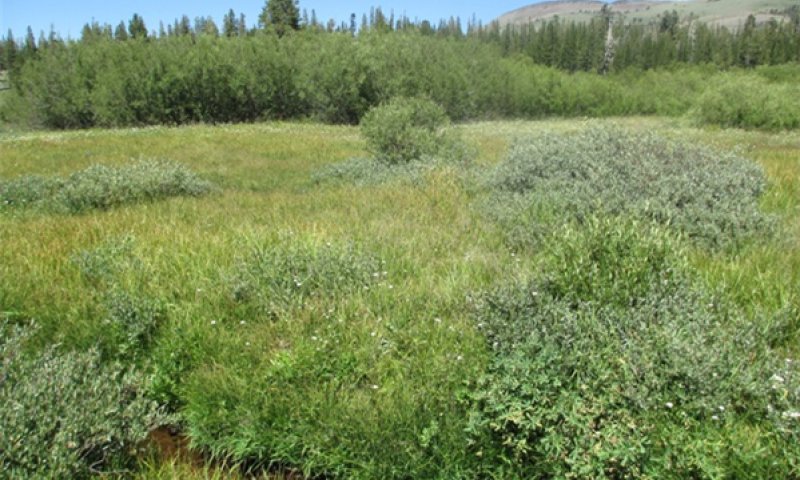
Figure 8. CT2 Floodplains
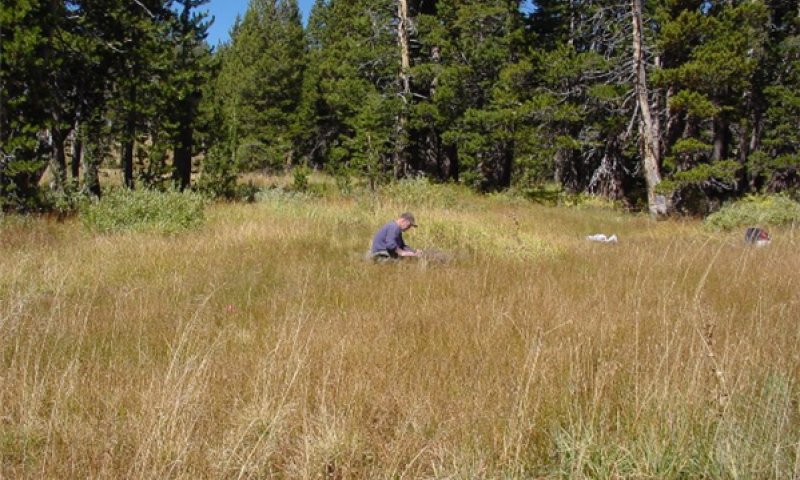
Figure 9. CT3 Floodplain Step
The E type channel flows through gently sloping alpine meadows. The channel is a small, stable, narrow, deep, meandering stream. These meadows maintain a high water table throughout the summer, and floods reach over the banks, two out of three years, which supports a healthy community of sedges and willows. Several community components are associated with this phase. CC1, Discharge slopes and depressions: This community typically occurs upslope of the main meadow, where subsurface flow seeps to the surface, creating a cool, perennially wet site that typically develops deep histic soil horizons. This component may also develop in depressional basins within the meadow. There are several plant communities that may occur on the discharge slopes. The variation is due in part by past disturbances, and in part by abiotic variation such as aspect. However, the scale required to capture these unique assemblages is beyond the scope of the soil survey. The most common plant communities are fen communities with high cover of mosses (Sphagnum and other sp.). Mountain sedge, Northwest Territory sedge (Carex utriculata) and spikerush (Eleocharis sp.) are dominant. Water sedge (Carex aquatilis), blister sedge (Carex vesicaria) and lakeshore sedge (Carex lenticularis) are present along small rivulets that have surface flow or ponded areas of standing water. Patches of mountain willow and Sierra willow can range from sparse to dense. Forbs typically are only a minor component and include (Arnica mollis), alpine shootingstar (Dodecatheon alpinum), Sierra shootingstar (Dodecatheon jeffreyi), willowherb (Epilobium sp.), alpine gentian (Gentiana newberryi), tinker's penny (Hypericum anagalloides), primrose monkeyflower (Mimulus primuloides), tundra aster (Oreostemma alpigenum var. alpigenum), Parish's yampah (Perideridia parishii), longleaf starwort (Stellaria longifolia), and western aster (Symphyotrichum ascendens). Meadow bistort (Polygonum bistorta) and California false hellebore (Veratrum californicum) may occasionally be dominant. CC2 Floodplain, frequently flooded: This community develops along the channel and on broad, frequently flooded floodplains. Mountain willow occurs along the stream and in the very wet areas. Sierra willow can be present or absent, and it may occur further from the stream. Other willow species may be present. In cooler or higher elevation sites western moss heather (Cassiope mertensiana), purple mountainheath (Phyllodoce breweri) and rose meadowsweet (Spiraea splendens var. splendens) are present. Mountain sedge is the dominant understory sedge, with bentgrass (Agrostis sp.), lakeshore sedge, Northwest Territory sedge, tufted hairgrass, slender hairgrass (Deschampsia elongata), pullup muhly (Muhlenbergia filiformis) and Donner woodrush (Luzula subcongesta) are often present. Forb diversity is relatively high. Common forbs include Pacific onion (Allium validum), alpine gentian, tinker's penny, bigleaf lupine (Lupinus polyphyllus), primrose monkeyflower, tundra aster, little elephantshead (Pedicularis attollens), Parish's yampah, Sierra bog orchid (Platanthera dilatata var. leucostachys), plantainleaf buttercup (Ranunculus alismifolius), woollyhead parsnip (Sphenosciadium capitellatum), and western aster (Symphyotrichum ascendens). CC3 Floodplain step, occasionally flooded: This community occurs on the floodplain step that occurs near the meadow edge. It is occasionally flooded, and slightly drier than CC2. Data for this community does not represent historic conditions, as it was collected in areas that were grazed in the past. Mountain rush, which is considered an increaser after grazing at the expense of grasses, is often dominant. Tufted hairgrass may have been more abundant and productive historically. Other grass-grasslikes include mountain sedge, pullup muly, alpine timothy (Phleum alpinum), bluegrass (Poa sp.) and meadow barley (Hordeum brachyantherum). Forbs include common yarrow (Achillea millefolium), tinker's penny, tundra aster, Parish's yampah, meadow bistort, slender cinquefoil (Potentilla gracilis), western mountain aster (Symphyotrichum spathulatum var. spathulatum), and California false hellebore (Veratrum californicum).
Figure 10. Annual production by plant type (representative values) or group (midpoint values)
Table 5. Annual production by plant type
| Plant type | Low (kg/hectare) |
Representative value (kg/hectare) |
High (kg/hectare) |
|---|---|---|---|
| Grass/Grasslike | 336 | 841 | 2018 |
| Shrub/Vine | – | 392 | 1233 |
| Forb | 6 | 73 | 347 |
| Total | 342 | 1306 | 3598 |
State 2
Unstable Channels
This state is characterized by unstable, entrenched G and F type channel types.
Community 2.1
G Channel
The phase is distinguished by a narrow, deeply incised G type channel. The banks are nearly vertical, with active slumping and erosion. The water level of the stream has incised 3 to 6 feet from the original elevation, causing the water table to drop throughout the meadow. The community components dependent upon frequent flooding, long durations of ponding and high water tables (CC1 and CC2) decline, and the vegetation shifts to drier upland species. CC1, Discharge slopes and depressions: This community may remain unaffected by channel incision if it receives water from a spring or seep. However at the lower reaches, the water table may drop and there may be some drying of this community. If the organic layer dries out, it is more susceptible to trampling and wind and water erosion. It is also more susceptible to burning, which would require a long time to redevelop the organic surface. Wetland species such as mountain sedge, Northwest Territory sedge and spikerush, water sedge, blister sedge and lakeshore sedge would decline. Development of gullies can shed water from the site, rather than holding the subsurface moisture. CC2b Floodplain, frequently flooded: This community is directly affected by a lower water table and reduced flood frequency. Mountain willow declines except in the wettest areas. Sedges will decline and grasses and rushes will increase. Lemmon's willow will replace mountain willow in incised channels at the lower limit of this ecological site. Species that establish or increase in this community are common yarrow, tundra aster, rosy pussytoes (Antennaria rosea), meadow barley, tall fringed bluebells (Mertensia ciliata), Rydberg's penstemon (Penstemon rydbergii), slender cinquefoil, tufted hairgrass, Sandberg bluegrass (Poa secunda) and mountain rush. CC3b Floodplain step, occasionally flooded: This community becomes drier and more dominated by upland grasses and forbs. Sierra lodgepole pine (Pinus contorta var. murrayana) or mountain hemlock may establish on these drier meadow margins. Fire is an important disturbance for keeping conifer forests from developing in these drier meadows.
Community 2.2
F Channel
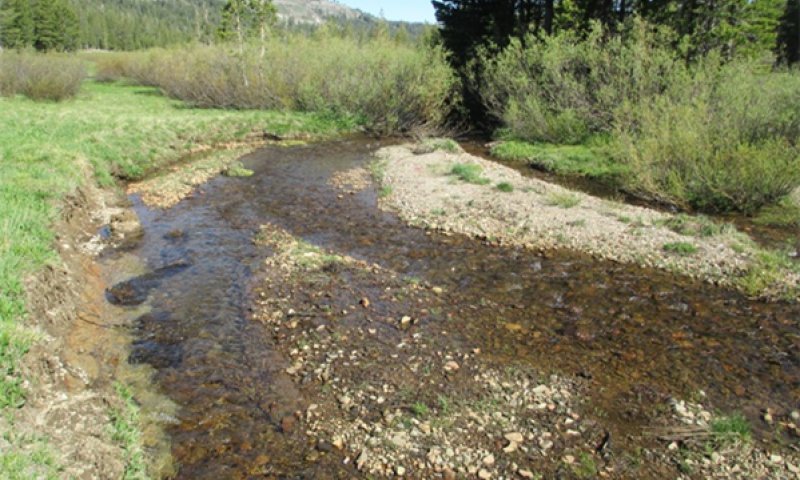
Figure 11. F Channel
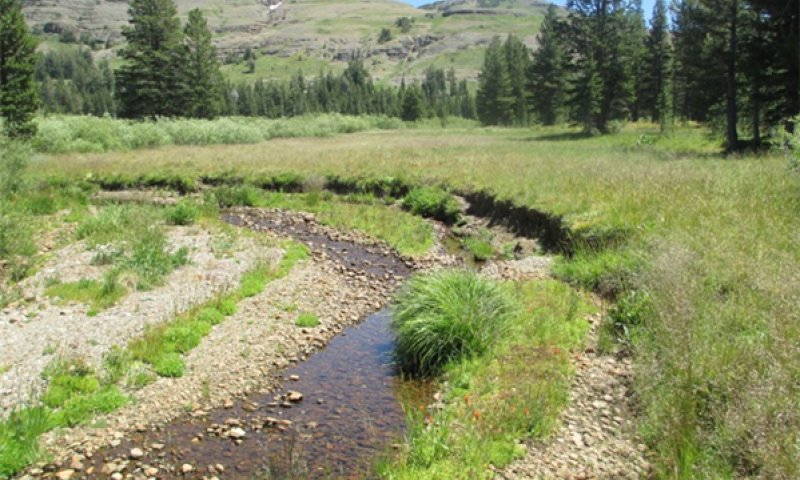
Figure 12. F Channel to C channel
The F type channel is wide, shallow and incised, with unstable actively eroding banks. Community components and community composition is similar as described in the G type channel phase. The wider channel and lack of vegetation on the banks, causes an exposed channel with little shade across the stream. Silt and sand from actively eroding banks causes a decline in habitat quality for fish and aquatic insects.
Pathway 2.1a
Community 2.1 to 2.2
This pathway develops as bank erosion continues to widen the channel forming an F type channel.
State 3
Re-established floodplain
This state has a relatively stable entrenched C or E type channel.
Community 3.1
C Channel entrenched
Only the initial stages of an entrenched C channel were observed. Point bars and lower floodplains have developed in some areas within F type channels. As the floodplains develop, there will be a new narrow floodplain that can support the water table dependent species in CC1 and CC2. However, these communities will be present at a much lower extent than prior to channel incision. CC2b and CC3b will remain on the upper abandoned floodplains.
Community 3.2
E Channel entrenched
The entrenched E channel resembles the original E type channel, but remains disconnected from the original floodplain. Northwest Territory Sedge, blister sedge, and water sedge will continue to develop and increase in cover and density along the channel. CC2b and CC3b remain dominant on the abandoned floodplain.
Pathway 3.1a
Community 3.1 to 3.2
This pathway is initiated with the development of a deep and narrow E type channel. The development of dense rhizomatous sedge roots has a very high influence on E type channel development.
Pathway 3.2a
Community 3.2 to 3.1
The E type channel may widen, and develop a C channel due to natural or human influenced disturbances. Beaver dams often widen the channel below the dam. Logs or root wads in the channel may cause deflection of flow, causing bank erosion. Channel manipulations such as road diversions, and realignments can alter the channel morphology.
Transition 1.1a
State 1 to 2
This transition occurs when the E and C type channel equilibrium is disrupted. This may be triggered by the loss of channel stabilizing vegetation, either from physical trampling or hydrological alterations that cause the water table to lower and subsequently cause a decline in the stabilizing vegetation. Manipulations such as channel straightening, confining the floodplain, or improperly designed road crossings can also trigger this transition.
Restoration pathway 2.1A
State 2 to 1
Restoration practices to restore channel conditions to state 2, vary depending upon site specific conditions. Removal triggers may allow these streams to stabilize over time. If livestock grazing is permitted in these areas, it would be best to keep them out of the wettest areas of the meadow. Trail and Road networks should be designed so they do not alter the hydrology by collecting or concentrating flow in a channel. Channel redesign may be necessary in some areas to increase channel meander, raise the channel bed level, and reconnect flows with the floodplain.
Transition 2.1a
State 2 to 3
This transition occurs when the F channel has widened sufficiently to allow for a C channel type to develop with a lower, re-established floodplain.
Restoration pathway 3.1A
State 3 to 1
Restoration from state 3 to state 1 is still desirable, even though these new channels are relatively stable there is still a disconnect from the original floodplain. Please see restoration pathway 2.1A for restoration approaches.
Additional community tables
Table 6. Community 1.1 plant community composition
| Group | Common name | Symbol | Scientific name | Annual production (kg/hectare) | Foliar cover (%) | |
|---|---|---|---|---|---|---|
|
Shrub/Vine
|
||||||
| 1 | Discharge slope | 73–118 | ||||
| mountain willow | SAEA | Salix eastwoodiae | 0–56 | 0–5 | ||
| western moss heather | CAME7 | Cassiope mertensiana | 0–45 | 0–5 | ||
| Sierra willow | SAOR | Salix orestera | 0–17 | 0–1 | ||
| 2 | Floodplain | 135–1233 | ||||
| Sierra willow | SAOR | Salix orestera | 22–1009 | 1–10 | ||
| willow | SALIX | Salix | 0–101 | 0–3 | ||
| mountain willow | SAEA | Salix eastwoodiae | 45–90 | 2–3 | ||
| rose meadowsweet | SPSPS | Spiraea splendens var. splendens | 0–22 | 0–1 | ||
| western moss heather | CAME7 | Cassiope mertensiana | 0–11 | 0–1 | ||
| purple mountainheath | PHBR4 | Phyllodoce breweri | 0–11 | 0–1 | ||
| 3 | Floodplain step | 0–168 | ||||
| mountain willow | SAEA | Salix eastwoodiae | 0–168 | 0–5 | ||
|
Grass/Grasslike
|
||||||
| 1 | Discharge slope | 785–2018 | ||||
| Northwest Territory sedge | CAUT | Carex utriculata | 11–1749 | 2–60 | ||
| mountain sedge | CASC12 | Carex scopulorum | 168–790 | 10–70 | ||
| spikerush | ELEOC | Eleocharis | 22–146 | 1–3 | ||
| blister sedge | CAVE6 | Carex vesicaria | 0–22 | 0–1 | ||
| water sedge | CAAQ | Carex aquatilis | 0–22 | 0–1 | ||
| lakeshore sedge | CALE8 | Carex lenticularis | 0–22 | 0–1 | ||
| sedge | CAREX | Carex | 0–22 | 0–1 | ||
| tufted hairgrass | DECE | Deschampsia cespitosa | 0–11 | 0–1 | ||
| bentgrass | AGROS2 | Agrostis | 0–11 | 0–1 | ||
| 2 | Floodplain | 560–1345 | ||||
| mountain sedge | CASC12 | Carex scopulorum | 56–796 | 2–70 | ||
| tufted hairgrass | DECE | Deschampsia cespitosa | 0–785 | 0–25 | ||
| Donner woodrush | LUSU7 | Luzula subcongesta | 0–504 | 0–30 | ||
| Northwest Territory sedge | CAUT | Carex utriculata | 0–135 | 0–8 | ||
| slender hairgrass | DEEL | Deschampsia elongata | 0–73 | 0–5 | ||
| pullup muhly | MUFI2 | Muhlenbergia filiformis | 0–22 | 0–2 | ||
| bentgrass | AGROS2 | Agrostis | 0–22 | 0–1 | ||
| lakeshore sedge | CALE8 | Carex lenticularis | 0–22 | 0–1 | ||
| 3 | Floodplain step | 448–1065 | ||||
| mountain rush | JUARL | Juncus arcticus ssp. littoralis | 280–897 | 40–70 | ||
| bluegrass | POA | Poa | 0–146 | 0–9 | ||
| tufted hairgrass | DECE | Deschampsia cespitosa | 0–90 | 0–5 | ||
| mountain sedge | CASC12 | Carex scopulorum | 22–50 | 150–650 | ||
| meadow barley | HOBR2 | Hordeum brachyantherum | 0–11 | 0–1 | ||
| alpine timothy | PHAL2 | Phleum alpinum | 0–11 | 0–1 | ||
| pullup muhly | MUFI2 | Muhlenbergia filiformis | 0–6 | 0–1 | ||
|
Forb
|
||||||
| 1 | Discharge slope | 6–135 | ||||
| Parish's yampah | PEPA21 | Perideridia parishii | 1–123 | 1–20 | ||
| primrose monkeyflower | MIPR | Mimulus primuloides | 0–11 | 0–3 | ||
| tundra aster | ORALA2 | Oreostemma alpigenum var. alpigenum | 0–6 | 0–1 | ||
| longleaf starwort | STLO | Stellaria longifolia | 1–6 | 0–1 | ||
| western aster | SYAS3 | Symphyotrichum ascendens | 0–6 | 0–1 | ||
| hairy arnica | ARMO4 | Arnica mollis | 0–6 | 0–1 | ||
| alpine shootingstar | DOAL | Dodecatheon alpinum | 0–6 | 0–1 | ||
| Sierra shootingstar | DOJE | Dodecatheon jeffreyi | 0–6 | 0–1 | ||
| willowherb | EPILO | Epilobium | 0–6 | 0–1 | ||
| alpine gentian | GENE | Gentiana newberryi | 0–6 | 0–1 | ||
| tinker's penny | HYAN2 | Hypericum anagalloides | 0–6 | 0–1 | ||
| 2 | Floodplain | 11–112 | ||||
| Pacific onion | ALVA | Allium validum | 0–168 | 0–5 | ||
| Parish's yampah | PEPA21 | Perideridia parishii | 0–39 | 0–3 | ||
| tundra aster | ORALA2 | Oreostemma alpigenum var. alpigenum | 0–22 | 0–1 | ||
| bigleaf lupine | LUPO2 | Lupinus polyphyllus | 0–22 | 0–1 | ||
| woollyhead parsnip | SPCA5 | Sphenosciadium capitellatum | 0–22 | 0–1 | ||
| western aster | SYAS3 | Symphyotrichum ascendens | 0–6 | 0–1 | ||
| primrose monkeyflower | MIPR | Mimulus primuloides | 0–6 | 0–1 | ||
| little elephantshead | PEAT | Pedicularis attollens | 0–6 | 0–1 | ||
| Sierra bog orchid | PLDIL | Platanthera dilatata var. leucostachys | 0–6 | 0–1 | ||
| plantainleaf buttercup | RAAL | Ranunculus alismifolius | 0–6 | 0–1 | ||
| alpine gentian | GENE | Gentiana newberryi | 0–6 | 0–1 | ||
| tinker's penny | HYAN2 | Hypericum anagalloides | 0–6 | 0–1 | ||
| 3 | Floodplain step | 73–347 | ||||
| slender cinquefoil | POGR9 | Potentilla gracilis | 6–202 | 1–15 | ||
| California false hellebore | VECA2 | Veratrum californicum | 1–185 | 0–5 | ||
| common yarrow | ACMI2 | Achillea millefolium | 0–73 | 0–5 | ||
| Parish's yampah | PEPA21 | Perideridia parishii | 6–62 | 1–10 | ||
| tundra aster | ORALA2 | Oreostemma alpigenum var. alpigenum | 0–50 | 0–4 | ||
| meadow bistort | POBI5 | Polygonum bistorta | 1–11 | 0–1 | ||
| western mountain aster | SYSPS | Symphyotrichum spathulatum var. spathulatum | 0–6 | 0–1 | ||
| tinker's penny | HYAN2 | Hypericum anagalloides | 0–6 | 0–1 | ||
Interpretations
Animal community
This site provides critical habitat for several species of birds. This site provides prime habitat for beaver. Deer, bear, and coyotes, use this area as well. This site can provide high quality habitat for fish and aquatic insects.
Hydrological functions
The hydrology of this site influenced primarily by the spring snowmelt. This ecological site provides for water catchment, sediment and nutrient storage when in good condition (State 1). It is a source for sediment and nutrients, when in poor condition (State 2).
Recreational uses
Some trails exist through these sites, however care should be taken to avoid compaction and water diversion.
Wood products
Not applicable
Supporting information
Inventory data references
The following NRCS plots were used to describe this ecological site.
State 1
056
100
Lo02H42A
lo02h51b
MH03H190
Slf03249
057 (Reference Condition)
098
054
lo03031
rx03056
h42b
Lo02h31
State 2
02CA693-213a
GR02H7 (Type location)
Gr02h6
02CA693-213b
LoM04044
State 3
059a
058
059c
059b
Type locality
| Location 1: El Dorado County, CA | |
|---|---|
| UTM zone | N |
| UTM northing | 4289641 |
| UTM easting | 760298 |
| General legal description | The type location is in upper portion of Meiss Meadow. To the east of the trail. |
Other references
Allen-Diaz, Barbara H. 1991. Water Table and Plant Species Relationships in Sierra Nevada Meadows. American Midland Naturalist, Vol. 126, No. 1 (Jul., 1991), pp. 30-43. Currently published by University of Notre Dame.
AECOM, and C. ENTRIX. 2013. Upper Truckee River and Marsh Restoration Project (EIR).in C. T. Conservancy, editor.
Beier, P., and R. H. Barrett. 1987. Beaver habitat use and impact in Truckee River Basin, California. Journal of Wildlife Management 51:794-799.
Castelli, Regine M.; Chambers, Jeanne C.; and Tausch, Robin J. 2000. Soil-Plant Relations Along a Soil-Water Gradient in Great Basin Riparian Meadows. Wetlands, Vol. 20, No. 2, June 2000, pp. 251-266. The Society of Wetland Scientist.
Cowardin, L.M.; Carter, V.; Golet, F.C.; LaRoe, E.T. 1979. Classification of Wetlands and Deepwater Habitats of the United States. U.S. Fish and Wildlife Service Report No. FWS/OBS/-79/31.Washington, D.C.
Davis, O. K. 1996. Pollen Analysis of a Mid-Lake Core from Lake Tahoe, California: Historic Vegetation Change. Sierra Nevada Ecosystem Project: Final report to Congress, Addendum.
Dwire, Kathleen A.; Kaufmann, Boone J.; and Baham, John E. 2006. Plant Species Distribution in relation to Water-Table Depth and Soil Redox Potential in Montane Riparian Meadows. Wetlands, Vol 26, No.1, March 2006, pp. 131-146. The Society of Wetland Scientist.
Elliott-Fisk, D. L., T. A. Cahill, O. K. Davis, L. Duan, C. R. Goldman, G. E. Gruell, R. Harris, R. Kattelmann, R. Lacey, D. Leisz, S. Lindstrom, D. Machida, R. A. Rowntree, P. Rucks, D. A. Sharkey, S. L. Stephens, and D. S. Ziegler. 1996. Tahoe Case Study. Sierra Nevada Ecosystem Project: Final Report to Congress.
James, C. D., and R. B. Lanman. 2012. Novel physical evidence that beaver historically were native to the Sierra Nevada. California Fish and Game 98:129-132.
Kie, J. G., and B. B. Boroski. 1996. Cattle distribution, habitats, and diets in the Sierra Nevada of California. Journal of Range Management 49:482-488.
Lahontan Water Board, and Nevada Division of Environmental Protection. 2008. Charting the Course to Clarity.
Landman, R., H. Perryman, D. Brock, and C. D. James. 2012. The historical range of beaver in the Sierra Nevada: a review of the evidence. California Fish and Game 98:65 to 80.
Martin, David, W. and Chambers, Jeanne C. 2001. Effects of Water Table, Clipping, and Species Interactions on Carex nebrascensis and Poa pratensis in Riparian Meadows. Wetlands, Vol. 21, N0. 3, September 2001, pp. 422-430. The Society of Wetland Scientist.
Muskopf, S. 2007. The effect of beaver (Castor canadensis) dam removal on total phosphorus
concentration in Taylor Creek and Wetland, South Lake Tahoe, California. . Natural Resources M.S.:35.
Rosgen, D. L. 1996. Applied river morphology. Wildland Hydrology, Pagosa Springs, CO
Rosgen, D. L. 1997. A Geomorphological Approach to Restoration of Incised Rivers in Proceedings of the Conference on Management of Landscapes Disturbed by Channel Incision.
Uchytil, Ronald J. 1989. Salix lemmonii. In: Fire Effects Information System, [Online]. U.S. Department of Agriculture, Forest Service, Rocky Mountain Research Station, Fire Sciences Laboratory (Producer). Available: http://www.fs.fed.us/database/feis/ [2007, January 26].
Weixelman, Dave A.; Zamudio, Desiderio C.; and Tausch,Robin J. 1997. Classifying Ecological Types and Evaluating Site Degradation. Journal of Range Management. 50(3).
Weixelman, Dave A.; Zamudio, Desiderio C.; and Zamudio, Karen A., 1999. Eastern Sierra Nevada Riparian Field Guide. USDA, Forest Service, Intermountain Region, R4-ECOL-99-01.
Contributors
Marchel M. Munnecke
Marchel Munnecke
Rangeland health reference sheet
Interpreting Indicators of Rangeland Health is a qualitative assessment protocol used to determine ecosystem condition based on benchmark characteristics described in the Reference Sheet. A suite of 17 (or more) indicators are typically considered in an assessment. The ecological site(s) representative of an assessment location must be known prior to applying the protocol and must be verified based on soils and climate. Current plant community cannot be used to identify the ecological site.
| Author(s)/participant(s) | |
|---|---|
| Contact for lead author | |
| Date | |
| Approved by | |
| Approval date | |
| Composition (Indicators 10 and 12) based on | Annual Production |
Indicators
-
Number and extent of rills:
-
Presence of water flow patterns:
-
Number and height of erosional pedestals or terracettes:
-
Bare ground from Ecological Site Description or other studies (rock, litter, lichen, moss, plant canopy are not bare ground):
-
Number of gullies and erosion associated with gullies:
-
Extent of wind scoured, blowouts and/or depositional areas:
-
Amount of litter movement (describe size and distance expected to travel):
-
Soil surface (top few mm) resistance to erosion (stability values are averages - most sites will show a range of values):
-
Soil surface structure and SOM content (include type of structure and A-horizon color and thickness):
-
Effect of community phase composition (relative proportion of different functional groups) and spatial distribution on infiltration and runoff:
-
Presence and thickness of compaction layer (usually none; describe soil profile features which may be mistaken for compaction on this site):
-
Functional/Structural Groups (list in order of descending dominance by above-ground annual-production or live foliar cover using symbols: >>, >, = to indicate much greater than, greater than, and equal to):
Dominant:
Sub-dominant:
Other:
Additional:
-
Amount of plant mortality and decadence (include which functional groups are expected to show mortality or decadence):
-
Average percent litter cover (%) and depth ( in):
-
Expected annual annual-production (this is TOTAL above-ground annual-production, not just forage annual-production):
-
Potential invasive (including noxious) species (native and non-native). List species which BOTH characterize degraded states and have the potential to become a dominant or co-dominant species on the ecological site if their future establishment and growth is not actively controlled by management interventions. Species that become dominant for only one to several years (e.g., short-term response to drought or wildfire) are not invasive plants. Note that unlike other indicators, we are describing what is NOT expected in the reference state for the ecological site:
-
Perennial plant reproductive capability:
Print Options
Sections
Font
Other
The Ecosystem Dynamics Interpretive Tool is an information system framework developed by the USDA-ARS Jornada Experimental Range, USDA Natural Resources Conservation Service, and New Mexico State University.
Click on box and path labels to scroll to the respective text.